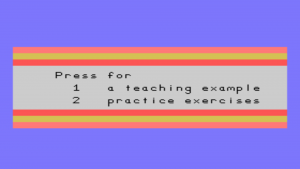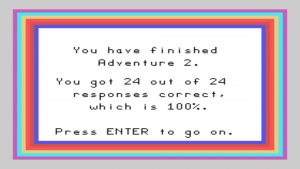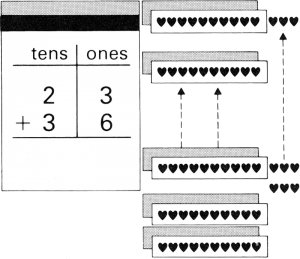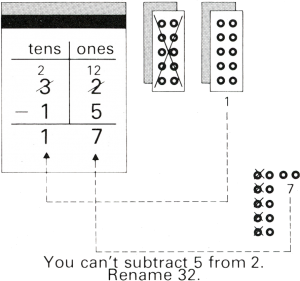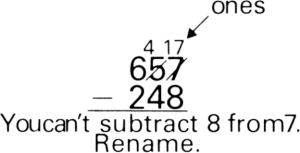Addition and Subtraction 3
Addition and Subtraction 3 is an educational software title developed by Scott Foresman Electronic Publishing for the TI-99/4A home computer system. It is the third title in the Addition and Subtraction series which expands young children's learning of mathematics, specifically in addition and subtraction skills. It was released during the first quarter of 1984 and originally retailed for $22.95 (USD). It was developed and programmed by Thomas Hartsig and was sold as a Solid State SoftwareTM Command Module cartridge. Addition and Subtraction 3 can take advantage of the optional Solid State SpeechTM Synthesizer add-on (sold separately) which enhances the activities with human-like speech.
| Addition and Subtraction 3 | |
|---|---|
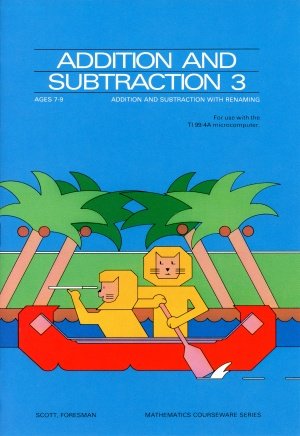 Addition and Subtraction 3 (Front Cover) [1] | |
| Publisher(s) | Scott Foresman |
| Original Retail Price | $22.95 |
| Programmer(s) | Thomas Hartsig |
| Part# | SF 30226 |
| Format(s) | Solid State SoftwareTM Command Module |
| Release | 1984 (1st Quarter) |
| Genre(s) | Educational, Mathematics |
Advertising Blurb
Manual
Addition and Subtraction 3 is an exciting way to practice mathematics. The module uses color, sound, music, and animation to bring math alive. The practice exercises challenge your child, and at the same time make learning fun. You can be confident that this module was carefully designed to provide a solid foundation in essential mathematics skills.
Manual
About the Module
Addition and Subtraction 3 is an exciting way to practice mathematics. The module uses color, sound, music, and animation to bring math alive. The practice exercises challenge your child, and at the same time make learning fun. You can be confident that this module was carefully designed to provide a solid foundation in essential mathematics skills.
Addition and Subtraction 3 teaches and provides practice in the second and third grade skills of addition and subtraction with 2- and 3-digit numbers. The module introduces the concept of renaming (carrying and borrowing) in addition and subtraction. The eight activities in Addition and Subtraction 3 follow the same sequence of skill-building that most classroom teachers use and should be done in numerical order.
Look for these special features in the module:
- simple instructions which allow children to use the module with little or no supervision
- teaching examples, practice exercises, and review activities
- built-in management that allows children to advance at their own pace and provides additional teaching examples when necessary
- musical and graphic rewards for correct answers
- color, sound, and animation
- voiced reinforcement of directions and correct answers through optional use of a speech synthesizer
- numbers which are randomly generated so children receive new problems each time the exercises appear
- two chances to answer each exercise correctly before the computer supplies the correct answer
- durable hardware and software components with useful keyboard functions programmed into the module
Getting Started
- Turn switched on.
- Insert module.
- Wait for the screen to appear.
- If you do not see the Texas Instruments title scree, check to see if:
- the computer keyboard and monitor are plugged in.
- the cable connecting the keyboard and monitor is properly connected.
- both the computer and monitor are turned on.
- the module is properly inserted.
Press any key. The Scott, Foresman copyright screen and the Addition and Subtraction 3 title screen are displayed. Next you will see the main selection list of activities:
The activities should be done in order since each activity is more advanced than the one before it. If you are working on the module for the first time, press 1 to go to the first activity. If you have worked with the module before, press the number of the next activity you want to do. When you press a number the activity title screen will appear. In every activity except the Review the computer will ask you to make a choice.
Press 1 to see a teaching example. You may see as many examples as you want before doing the practice exercises. Press 2 to go directly to the practice exercises. Follow the directions on the screen for each activity. As you do the exercises, the computer keeps track of how you are doing . If your score is 80% or higher you will see your score, and you can go on.
If, however, your score is less than 60%, you will see the following screen, and a sample problem will be shown. You can see as many sample problems as you want before a new set of practice exercises is given.
If your score is between 60% and 80% the computer will continue giving problems until your score falls below 60% or goes above 80%.
You can use the special function keys to return to the list of activities at the beginning of the module, to start an activity over again, or to get help with the activity you are working on. See the inside front cover of this book for an explanation of these and other special functions built into Addition and Subtraction 3.
When you are finished working on the module, press FCTN = (QUIT). The Texas Instruments title screen will reappear and you may safely remove the module.
About the Activities
Add 2-Digit Numbers
Two teaching examples show the addition of two 2-digit multiples of ten and the addition of two 2-digit numbers. Each number is graphically represented and the addition process is illustrated on the screen. In the practice exercises which follow each teaching example the digits of the sum must be entered.
Subtract 2-Digit Numbers
The teaching example demonstrates the subtraction process used for two 2-digit numbers. No renaming, or borrowing, is necessary. In the practice exercises, each digit of the answer must be entered in subtraction problems which use 2-digit numbers.
Regroup Objects
The first teaching example demonstrates regrouping when there are more than 9 ones, a skill necessary for addition with renaming ("carrying"). The second teaching example demonstrates regrouping one ten to have more ones, a skill which is necessary for subtraction with renaming ("borrowing"). Practice exercises follow each teaching example.\
Add with Renaming
The teaching example graphically demonstrates the addition of two 2-digit numbers when renaming, or carrying is necessary. The practice exercises give addition problems which use two 2-digit numbers and reguire renaming.
Subtract with Renaming
In the teaching example, a 2-digit number is represented graphically and the subtraction process, including renaming, is demonstrated visually. In the practice exercises subtraction problems which use 2-digit numbers and require renaming are given.
Add 3-Digit Numbers
The teaching example illustrates two addition problems, each of which has two 3-digit numbers and requires renaming of either the ones or the tens. Each of the practice exercises which follow requires one renaming.
Subtract 3-Digit Numbers
The teaching example illustrates two subtraction problems, each of which has two 3-digit numbers and requires renaming of either the tens or the hundreds. Each of the practice exercises which follow requires one renaming.
Review
Problems are given from each of the first seven activities. Only one chance is given to answer each problem. At the end of the activity a score is given, as well as a list of activities that need more practice.

